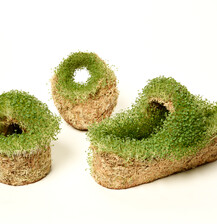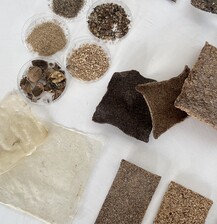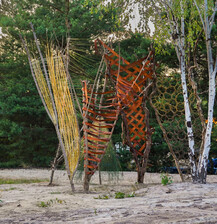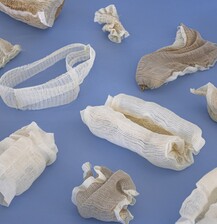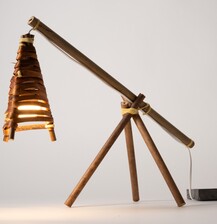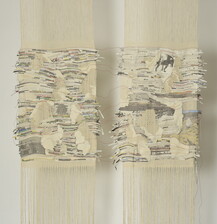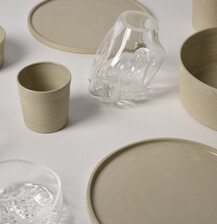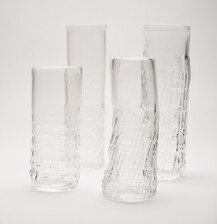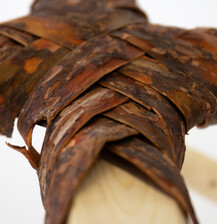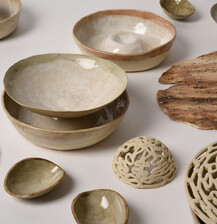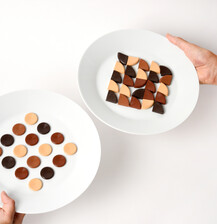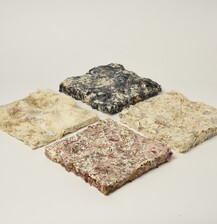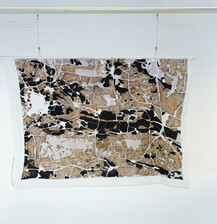Sommersemester 2023, BA/MA Produkt-Design , BA/MA Textil- und Material-Design , BA/MA Visuelle Kommunikation GreenLab , Produkt_Startseite , Textil_Startseite , VK_Startseite
GreenDesign 12.0– Verflechtungen
Potentiale für nachhaltiges Design im ländlichen Raum
Flechten ist eine jahrtausendealte Kulturtechnik. Sie machte es möglich, mehr zu sammeln, als man in der Hand tragen konnte. Und Flechtwerk schützte. Als Transportschutz um zerbrechliche Gefäße aus Keramik und Glas – Flasche leitet sich vom althochdeutschen Wort flaska für »umflochtenes Gefäß« ab – oder als Wand, deren Etymologie auf das Winden von Weidenruten zum Ausfachen von Fachwerk verweist. Flechten im biologischen Sinne sind Lebensgemeinschaften aus Pilzen und Algen, die erst in der Symbiose ihre besonderen Eigenschaften und Wuchsformen herausbilden. Verflochten sind regionale Akteure in sichtbaren und unsichtbaren ökonomischen, sozialen, politischen und kulturellen Beziehungen. Unsere Existenz als Spezies ist untrennbar verbunden mit der einer großen Zahl anderer Lebewesen.
Im greenlab 12.0 im Sommersemester 2023 wollen wir die verschiedenen Dimensionen des Flechtens, Flechtwerks und Verflechtungen untersuchen. Am Beispiel des Landstädtchens Baruth – ca. eine Stunde südöstlich von Berlin im Landkreis Teltow-Fläming – wollen uns mit lokalen Rohstoffen, handwerklichen Techniken, Verbindungen zwischen Organismen, ökonomischen und kulturellen Verflechtungen und ihrer Gestaltbarkeit beschäftigen.
Dabei geht es insbesondere um:
· Material im Kontext des Landstädtchens Baruth und des Glasmacherdorfs Klasdorf/Glashütte
· Materialströme in Baruth und Schnittstellen nach außen
· Infrastruktur und Netzwerke im ländlichen Raum
· Symbiotische Stoffwechselprozesse und ihre Potentiale für Design
· Arbeiten mit lebendigem Material (Holz, weitere pflanzliche Rohstoffe etc.)
· Handwerk als Kulturtechnik, Wissensform und Nachhaltigkeitsstrategie
Projektpartner: Museum Baruther Glashütte, Hochschule für Nachhaltige Entwicklung Eberswalde, Museum Europäischer Kulturen (Ausstellung: All Hands on Flechten)
Eingeladene Expert_innen:
Charlett Wenig / Materialforscherin, Workshop: Naturmaterialien verstehen und anwenden am Beispiel von Baumrinde – Materialforschung im Spannungsfeld Naturwissenschaft und Design (Deutschland)
Evey Kwong / futurprimitiv, Workshop: 50 Twines Experiment (Deutschland / Malaysia)
Malu Lücking / Designforscherin, Workshop: Material zur Fläche – Gestalten mit (Bio-)Materialien aus Baruth (Deutschland / Ungarn)
Jouw Wijnsma und Martin Kullik / Steinbeisser, Workshop: Ethical Sustainable Crafts (Niederlande)
Ella Einhell / Designerin und Materialforscherin (Deutschland)
Sofia Botvinnik / Kuratorin All Hands On Flechten, MEK (Deutschland)
Projects:
Growing Entanglement– Inyeong Song
A long time ago in Korea, ginseng hunters collected wild ginseng deep in the mountains and carried it to the villages. To transport the ginseng, which is a precious folk medicine, they wrapped it into moss. Thanks to the moss‘s ability to keep a constant temperature and humidity, the ginseng stayed fresh during the whole trip.
Moss has a wide adaptability, it stores water and nutrients, and it purifies the air by decomposing carbon dioxide and fine dust. These properties even play a major role in the formation of forests. Moss can live on dry land with little sunlight. As it starts growing there, it makes the land greasy and fertile and helps other plants to enter. Small insects come in and grasses sprout. Eventually, trees grow to form a forest.
This project started by asking ‘how can we bring these ecosystems closer to our lives?’, as we live in a new barren land, the city. And it developed into a collaboration with nature about how we can design together.
I am going nuts– Karola Kulcsar
Walnuts are delicious, healthy, have a deeply rooted history and are becoming increasingly popular again, but what about their shells? Their hard yet light material could be of use, but instead they disappear in the trash. However, at the Böllersen Walnussmeisterei, which is dedicated to the replanting of walnut trees in Brandenburg and has its own cracking machine, walnut shells are collected, but only to be used as firewood.
For me, the main task was to develop a new, sustainable material from walnut shells. On the one hand, to give this „worthless“ part of the walnut a value after all, and on the other hand out of interest in its actual potential. So they were ground to different finenesses and processed with different binders into flat composite materials. The result is a wide variation in hardness levels, surface structures and looks.
Dome Deconstructed– Zoe Kreiße, Linus Rüllmann
Dome Deconstructed transformiert regionale pflanzliche Materialien in eine temporäre soziale Architektur. Aus Astgabeln und natürlichen Membranen entstehen Module, die sich beliebig verbinden und in immer neu- en Kombinationen einsetzen lassen. Alle Bestandteile wurden dem Raum Berlin-Brandenburg entnommen und mit handwerklicher Raffinesse für ihre gestalteri- sche Verwendung vorbereitet. Die Astgabeln wurden auf ihre Grundform reduziert und für die Membranen wurde unter anderem Baumrinde in Streifen geschnit- ten, flexibel gemacht und geflochten sowie Weidenstäbe zu geometrischen Mustern zusammengesetzt.
Die “Pavillons” bieten, außer dass sie Schatten spenden, keine baulichen Funktionen. Sie bilden von der Natur und dem Menschen gestaltete hybride und variable Raumkonfigurationen, die von der Unterschiedlichkeit jedes einzelnen Moduls geprägt sind. Durch ihre ge- wachsene Grundform ähneln diese eher Individuen, die miteinander in Beziehung treten und fast wie in einem Tanz miteinander verbunden sind.
Emergent– Sara Hassoune
Emergent explores the potential of textiles’ inherent material qualities and structures to generate three-dimensional woven objects. Inspired by the practice and techniques in traditional basketry, particularly the simultaneous creation of fabric and form, emphasis is put on the transfer and embedding of the materials’ properties into the woven fabric. Using natural and local materials, wool, linen and paper yarn, varying degrees of stiffness are combined and accentuated. In addition, multilayered, interwoven structures interact with the materials’ behaviour and allow for more volume. On the loom the fabric remains flat, but once released, the inherent tension of the threads is activated and expands the weave into the spatial. The emergence of form here is based on an intuitive interplay between maker and material. The weaver gives the material room to move instead of constraining it into shape, and reacts to it and its forces in the process. The resulting object is seen as a co-creation with the material.
Craft IY– Alice Paupini, Jonathan Bläsi
Crafts bring people together. In an increasingly technological world, the pleasure of creating things oneself has not yet been lost. Moreover, sharing a hobby has always been a good source for community building. CraftIY links the general act of tinkering with natural materials of the region of Berlin-Brandenburg and helps people to connect with their own territory. It is an open source, community based online platform that as a starting point focuses on two particular craft techniques: Weaving tree bark and Knotting wooden sticks together. The platform offers a community forum and information on the sur-rounding nature, in addition to tutorials and examples for both tech-niques and the combination of the two. Eventually, using them to create frames and surfaces will enable people to build objects for everyday uses in a sustainable way.!It requires a very little budget since the main materials are collected in the woods and no expensive tools are needed. Therefore it represents in some cases a solid, more sustainable alterna-tive to traditional shopping.
2 hours 54 minutes– Bar Esh, Melissa Kurt
2 hours, 54 minutes is a large-scale tapestry that represents our experience with nature as an unfamiliar place. A place characterized by its own rules and structures. For spaces existing outside social norms, Foucault coined the term Heterotopia. Our work is inspired by cartography and natural formations. It is made entirely of natural materials, takes up formal structures of tree bark, which thus embodies the forest.
We worked together on one loom using traditional weaving techniques. The result are two separate works that merge into each other and thereby enter into a dialogue. The title of the work is a time designation. It refers to the distance between Berlin as the place of creation, and the forest near Baruth, where this project was conceived. The red thread symbolizes the time invested in the weaving process, establishes a rhythmic connection between the two pieces and allows a whole to emerge from them.
Krume, Krust, Klasdorf– Theresa Schiebel
In diesem Projekt ist das Backen eines Kuchens zugleich Anlass für den Austausch mit den am Prozess Beteiligten: Wer hat die verwendeten Mehle zur Verfügung gestellt, von welchem Hof kommen die Eier, wo und wie werden die benötigten Molkereiprodukte gewonnen? Ausgangsort für das entstandene Netzwerk an Produzent*innen, Handwerker*innen und allen, die bezüglich meiner Idee Wissen mit mir geteilt haben, ist der Ort Klasdorf Glashütte. Es ergaben sich vielfältige Verflechtungen – unter Menschen, mit der Natur, aus dem Zusammenwirken von Handwerk, Gestaltung und Produktion. Die Herstellung des Kuchens wie auch der an eine Gugelhupf-Form angelehnten keramischen Backform lässt sich als Zusammenspiel von meinem persönlichen intuitiven Vorgehen, den realen Gegebenheiten und einem sozialen Prozess verstehen. Die Rezeptur meines Kuchens entwickelte ich in einer Reihe von Backversuchen stetig weiter, bis der Geschmack und das “Mundgefühl” mit den verarbeiteten Elementen am besten in Einklang stand. Spannend war für mich auch der schrittweise Übergang von einem traditionellen handwerklichen Vorbild zu einem neuen, erst durch den Prozess greifbar gewordenen regional-spezifischen Produkt. Am Ende des Projekts fanden sich die Beteiligten an einer großen Kuchentafel – gedeckt mit den selbst gefertigten Lebensmitteln und handwerklichen Erzeugnissen – zusammen.
artefakt– Victoria Fechtner
In cooperation with Baruther Glashütte and glassmaker Torsten Rötzsch, I have realized a series of cylindrical glass vases on whose surface imprints of woven patterns are visible. The glass was blown into an elaborate basket weaving, which burned shortly after coming into contact with the hot glass. However, its image remains permanently preserved, serving as a reminder of the long tradition of basketry as a protective covering for glass containers.
In the vase, two interconnected craft traditions are combined, implicitly representing two different materials as well. With reference to the traditional everyday objects that it thematizes, the vase can be understood as a timeless artifact in itself. Simultaneously, through the relationship of the materials incorporated within the object, it exemplifies the connection between permanence and transience.
Tree to one– Paul Engelmann
Tree to One is a conceptual furniture project. It transforms an entire, roughly fifteen year old, pine tree into exactly one stool, with no added or wasted material. To that end the stools proportions are directly related to the dimensions of the tree while the design allows, through careful planning and technical ingenuity, reassembly of the tree in its new form without external connectors such as glue or screws. Despite natural variations in the trees, the resulting stools resemble a serialised industrial product.
The undried wood is cut into elements, lightly processed, then pressed into its shape as green wood. The pine bark is then woven onto the frame and finally, the pine oil extracted from the needles of the tree can be applied to the wood to offer a protective film.
Trophe Symbiosia– Antonia Leonie Steinbrink,Prerana Maheshwari
The intake of food is deeply rooted in many cultures represented by daily rituals and traditions. In nature, too, processes and routines to absorb nutrients take place on a daily basis. An extensive network of roots extends underneath the earth. Through this network, nutrients are exchanged and passed on, feeding all the connected organisms. “Trophe Symbiosa” is an eating experience that makes the eating cultures of mycorrhizal fungi, trees and lichens visible and tangible. It includes a set of ceramic objects and a four-course menu. Each course refers to a storey of the forest and illustrates the interactions happening there between the living organisms: starting from the roots and moving to the treetops. The ceramic objects are stacked during the meal. Thus, the forest also builds up figuratively.
Bites– Tommy Levy
In recent years, there has been growing interest in alternative protein sources, and one of the most intriguing options is insect-based protein food. Consuming insects is not only sustainable and environmentally friendly but also offers numerous health benefits. However, the main issue lies in people’s reluctance to try insect-based food, often shown in expressions of disgust and sounds of ‚Ew‘.
Bites, as a design project, addresses this challenge by gently manipulating and nudging people to develop an interest in food normally rejected. It consists of a series of three chocolate praline designs that play with the motives behind people’s appetite. Is it the colors, the texture, the shape, or is it all culture-based and education-driven?
Bites seeks to entice people to try small sweet praline containing grasshopper protein powder as a starting point, with the ultimate goal of helping them overcome their mental block. So, go ahead and have a BITE.
MyGrow– Anna Honegger
Mushrooms are often associated with a sense of negativity. Mold in houses or on our food. They infest our belongings, rendering them useless. But what if we could also use this process? Because if we bring them together with another material, a self-growing composite material is created.
MyGrow uses this property to combine discarded old texti- les into a new material. From a mountain of T-shirts, a stable, lightweight and fully compostable building material is created with the help of the oyster mushroom. In this project, the material‘s sound-absorbing and optical properties are used for modular acoustic panels. The wavy surface structure not only serves to disperse sound waves, but also creates a large-scale, aesthetic overall appearance thanks to the combinability of the modules.
Böden der Zukunft– Lea Pesch
Mit dem Kartierungsprozess wird ein fossiler Abdruck der lokalen Böden des Baruther Urstromtals geschaffen, der jenes zum Vorschein bringt, was bis zu einem Meter unter der Oberfläche liegt und somit 11.000 Jahre Geschichte in sich trägt. Durch die Einordnung von drei anthropozäne Eingriffe in die Bodenökologie wird über Flächenpotenzial sowie -gefährdung gesprochen. Die forstwirtschaftlich genutzten Mischwälder werden als lebendig und am „natürlichsten“ durch den Abdruck ihrer diversen Schichten dargestellt. Sie bewahren das meiste organische Leben für Pflanzen und Tiere und sind mit Blick in die Zukunft die wichtigsten Kohlenstoffspeicher. Die landwirtschaftlich genutzten Agrarfelder sind mit dem schwarzen Eisenoxid-Pigment (Teil des Bodens im B-Horizont) gekennzeichnet und schaffen durch ihre ästhetische Konnotation zur Asche eine kritische Auseinandersetzung mit dem Gebrauch der Böden zur Energiegewinnung und Verbrennung ihrer Nährstoffe. Die versiegelten Flächen sind unbedruckte leere Flächen, die als tot bzw. verloren gelten. Die Karte schafft einen Rahmen zwischen intuitiv physischen und analytisch abstrahierten Erfahrungsmöglichkeiten.
Die Böden drucken ihre eigene Karte über sich selbst und laden zum Bestaunen ein. Der Druck der verschiedenen Schichten holt das hervor, was für viele von uns versteckt liegt und schafft neue Berührungspunkte, die sonst vergraben bleiben. Durch „Soil Sensing*“ wird die Möglichkeit der sensorische Wahrnehmung und Wertschätzung von Bodenmaterialien geschaffen. Das künstlerische Projekt trägt eigenständig zu einer kollektiven Bodenbewusstseinsbildung und zur Vermittlung von Bodenwissen bei.
Durch die Abbildung der zeitlichen Schichten und lokaler Beziehung der Bodengegebenheiten wird eine ganzheitliche Betrachtung des Bodens als Körper beabsichtigt. Es wird eine neue Form der Kommunikation mit Hilfe von Kartierung geschaffen, die über Bodenbelastung, Verlust an organischem Kohlenstoff und Bodenversiegelung spricht. Künstlerisches „Soil Sensing“ kann darüber hinaus eine materielle und emotionale Identifikation mit dem Ort schaffen, Neugier und Staunen befördern und eine Wiederverbindung mit der Landschaft herstellen
